Exhibition texts
Pallavi Paul: How Love Moves
Against the backdrop of the COVID-19 pandemic, the act of breathing has turned from an individual into a social act, layered with medical, historical and political reverberations across the globe. While streams of images from this catastrophic time of contagion circulated through media spheres, Pallavi Paul – as an artist, filmmaker and scholar of cinema – discerns, within this sensorial abundance, a crisis in vision. Through the lens of poetry and the cinematic, Paul now turns to the invisible aspects of the breath, situated at the margins of the documentable.
Following a year-long residency at the Gropius Bau in 2023, Pallavi Paul’s solo exhibition brings together her early moving image work and most recent cinematic productions with immersive spatial installations. Her newly produced films intertwine contemporary health care crises and the spreading of tuberculosis around the turn of the 20th century in Germany. They explore illness not as a metaphor but as an ethical, spiritual and biopolitical phenomenon in New Delhi, Berlin and beyond.
How Love Moves traces the cycle of breath across lovers, collective dying, ruination and mourning amidst the impacts of industrial society and collapsing health infrastructures. It further reflects on breath as a planetary language and a continuous process of circulation, connecting the individual to all living entities.
Salt Moon
2023, multi-media-installation
Salt Moon imagines the graveyard as a portal into grief but also as a place of rest, recovery and remembrance. Here, sculptures resembling graves become surfaces for projection, alluding to animal life on the Delhi Gate Cemetery in India’s capital New Delhi. Immersed by a soundscape of prayers and chanting, the installation forms a liminal space of mourning, memory and desire. It is also an impulse to cherish the love of the absent as it expands through the subsequent exhibition choreography on- and off-screen.
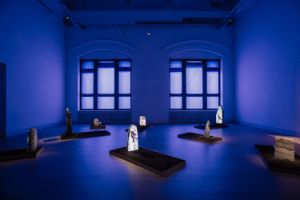
Pallavi Paul, Salt Moon, installation view, Gropius Bau, 2024
© Pallavi Paul, photo: Luca Girardini
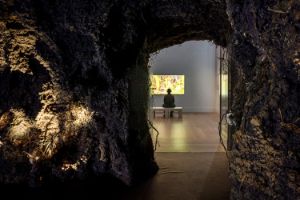
Pallavi Paul, Slumber, installation view (detail), Gropius Bau, 2024
© Pallavi Paul photo: Luca Girardini
Nayi Kheti / New Harvest
2013, video, 11 min
This short film reconsiders the idea of authorship and truth, tracing a fictional conversation between three poets – Jack Spicer, Federico García Lorca and Ramashankar Yadav (also known as Vidrohi) – across different timelines and geographies. Influenced by the US-American poet Jack Spicer’s publication After Lorca (1957), in which he enters into an imagined dialogue with Spanish poet and playwright Federico García Lorca nearly 20 years after his death, Nayi Kheti / New Harvest asks: What do you do with a poem once it is over? In this filmic work, Pallavi Paul envisions Lorca’s response from the beyond as a vantage point from which to reconsider the afterlife of a document. Filmically connecting Spicer’s material to the writings of Indian poet and university campus activist Ramashankar Yadav, whose work circulated mostly orally, Paul tackles the question of the (post-) document from a new perspective.
Slumber
2023, multi-media-installation
In this immersive room-within-a-room, visitors are invited to transgress human perspectives on time, love and place by engaging with the living ground beneath our feet. Collating multiple short love stories fully rendered from online sources, Pallavi Paul brings together interlinked scenarios from poetry, industrial labour, geology and the realm of the more-than-human. By placing moving images within organic matter, Slumber creates a space to reflect on soil as both a material and a habitat where new life continuously emerges from decay.
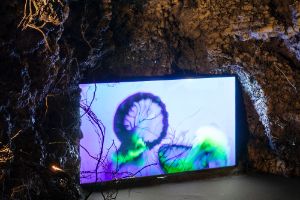
Pallavi Paul, Slumber, installation view, Gropius Bau, 2024
© Pallavi Paul, photo: Luca Girardini
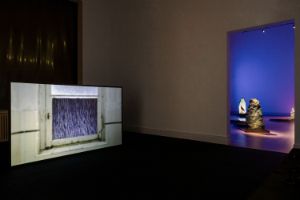
Pallavi Paul, Twilight’s Envelope / Und in der Dämmerung Hülle, installation view, Gropius Bau, 2024
© Pallavi Paul, photo: Luca Girardini
Twilight’s Envelope / Und in der Dämmerung Hülle
2024, video, 20 min
Fusing narrative and temporal strands within the documentary through new footage and archival material, this experimental essay film captures the remnants of the Heilanstalten Hohenlychen, a former tuberculosis facility that opened in Brandenburg (near Berlin) in 1902. Now overgrown by layers of dust, plants and animal life, the film attends to the building’s unresolved past, which is permeated by attempts to both cure and violate bodies. In 1942, after the sanatorium had been converted into a military hospital in the First World War and a sports sanatorium during the Nazi regime, the facility’s doctors and medical staff arranged and committed brutal experiments on inmates of Ravensbrück, the largest women’s concentration camp on Germany territory.
Textured by the recollections of factory worker Moritz Theodor William Bromme, a tuberculosis patient who chronicled daily life in a sanatorium in his journal Lebensgeschichte eines modernen Fabrikarbeiters (1905), the film carries viewers through an architectural ruin haunted by psychological, bodily and spiritual remnants of the past.
Trousseau
2024, embroidered fabric
Body bags have become a painful emblem of how death is rendered impersonal in times of crisis and contagion. During the height of the COVID-19 pandemic’s second wave with infection figures at an all-time high and subsequent oxygen shortages in Northern India, images of bodies in zipped up bags continuously circulated in news outlets and public announcements. To reclaim the dignity and intimacy of death and mourning, each body bag in Trousseau is uniquely embroidered by a group of New Delhi-based women in the style of bridal garments, featuring motifs associated with fertility. It is through their labour, their prayer and yarn that the memories of lives lost are woven into the otherwise sterile, mass-produced medical objects.

Pallavi Paul, Trousseau / Everything is Still Damp, installation view, Gropius Bau, 2024
© Pallavi Paul, Foto: Luca Girardini

Pallavi Paul, Trousseau, installation view, Gropius Bau, 2024
© Pallavi Paul, photo: Luca Girardini
Everything is Still Damp
2024, screenprint on sandpaper
The series Everything is Still Damp similarly features floral motifs and ornaments dedicated to both the persistence and the fading of memories. The screenprints on sandpaper show roses and the patterns of a chadar, a textile which in the Islamic tradition is laid on graves as a symbol of respect and care for the deceased. The manual production process of the prints on the rough surface creates variations of the original motifs, which allude to the dissolution, fragility and transience of memory.
The Heart of the Heart
2021, digital print on linen
The Heart of the Heart refers to the circulation of journalistic images during the catastrophic second wave of the COVID-19 pandemic in New Delhi. Digitally stacked and inverted, the photographs produce an imageless void that is materialised as a shroud which resists the amnesia of rapid news cycles.

Pallavi Paul, Trousseau, installation view, Gropius Bau, 2024
© Pallavi Paul, photo: Luca Girardini
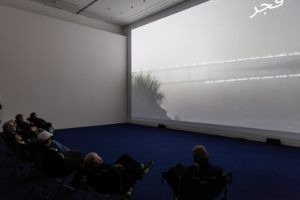
Pallavi Paul, How Love Moves, installation view, Gropius Bau, 2024
© Pallavi Paul, photo: Luca Girardini
How Love Moves
2023, video, 63 min
This experimental documentary film revolves around one of the largest Islamic cemeteries in New Delhi, surrounded by the beauty of multispecies and spiritual life, as well as the brutality of political and racialised violence. Following Shamim Khan’s and his co-workers’ daily care for the Delhi Gate Cemetery over the last two years, the film attempts to comprehend an event unprecedented in the recent history of the world – the COVID-19 pandemic – through the eyes of a keeper of the dead.
As a cinematic structure, Pallavi Paul unpacks the timespan of a breath through five chapters titled after Islamic prayer times – فجر (Fajr, before dawn), ظُهْر (Zuhr, afternoon), العصر (Asr, late afternoon), مَغْربِ (Maghrib, after sunset) and عائشة (Isha, nighttime) – which simultaneously mark a disruption in the prayer’s connection to the circle of life. Eventually, How Love Moves also traces a cross-border love story that defies religious divides and yet ends in loss. It relays the daily cost of mortality in an authoritarian nation and how caregiving manifests across devotional acts at the onset of death.